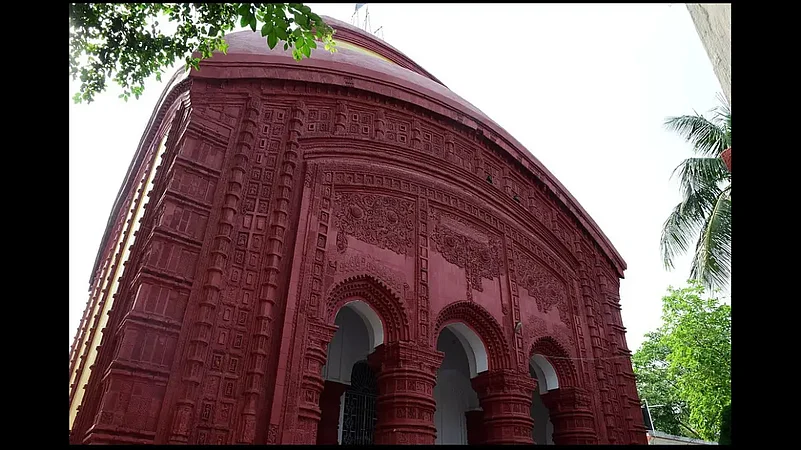When you think of intricate terracotta work on temples in Bengal, it's always Bishnupur which comes to mind. But a slight turn of roads will lead you to a hidden gem of a village which has similar artworks.
A two to three hour drive from Kolkata will take you to Gurap in the Hooghly district, an ideal destination for a day trip on a weekend.
The quaint village is dotted with temples dedicated to Krishna and Shiva which are embellished with priceless terracotta works dating back to the 19th century. The walls, roofs and panels of these temples are embellished with terracotta tiles that showcase tales from the past with their intricate detailing.
The most important temple and place of interest in Gurap is the Nandadulal Temple or the Sri Sri Nandadulal Jew Mandir. The word ‘Jew’ here does not refer to anything Jewish, it is another form of the commonly used Hindi suffix ‘ji’.
Built in 1751 by the then affluent zamindar and landlord family of the Nags, the temple is dedicated to Radha-Krishna. Local zamindar Ramdeb Nag had established the temple in the traditional ‘aatchala’ style of Bengali architecture. In a traditional ‘charchala’, four triangular roofs meet at a point and if this structure in slightly truncated with a miniature ‘charchala’ added on top, it becomes ‘aatchala’ ('aat' = eight).
The temple complex has the main platform for the deity along with a Rasmancha, Dolonmancha and a Naatmandir. The handmade ornamental patterns and carvings of terracotta that adorn the main façade of the temple will take your breath away. Events from Krishna’s birth, the killing of Kamsa and other motifs of the Mahabharat and Ramayan are woven into these terracotta works.

Slabs illustrating incidents showing death, ‘mrityutala’, can be seen along with a few slabs which depict erotic motifs. One of the tiles show a tiger devouring a rider while one shows men fighting. Fight scenes from the ‘Kamsa Vadh’ episode of Krishna’s life, and ‘Ravana Vadh’ from Ramayana are also showcased.
Several other buildings in the complex also have their share of such wonders. For instance, one of the tiles in the Naatmandir has erotic motifs as well. Browse the different spaces and you will see how temples of that time were seats of learning. These terracotta tiles establish how temple architecture and its adornments in those days were used to spread awareness about all aspects of life. They bring to mind the beautiful carvings on the Khajuraho temple.
Close to the Nandadulal Temple are a pair of twin Shiva temples. Built in the ‘pancharatna’ style, where a large tower central on the roof of the temple is surrounded by four smaller towers, these structures have detailed and in-depth terracotta works with mostly floral and ornamental patterns.
If you are a mathematics addict, KC Nag’s name would be familiar to you. The revered mathematician, who was also imprisoned during the British rule for his association with the Quit India Movement, was born into the Nag family in Gurap. The house still remains intact.
Moving further north, you will come across a pair of twin Shiva temples. The same ‘aatchala’ pattern terracotta tiles with floral and bird motifs can be found on the façade of these temples. Though the body had to be renovated with cement, the charm of a bygone era can be felt in the in-depth work and in the handmade patterns on the slabs of burnt clay. These century-old temples are still active today with regular prayers and offerings. If you are interested in attending, the residents of the area will tell you about puja timings.
Getting there: Gurap is a small village and is ideal for a day trip. You can easily drive down, or take a local train from Howrah station.
Best time to visit: Avoid the scorching heat and visit in winter, or the monsoon. It is the best time to experience the morning pujas and rituals that take place here. You can pack a picnic meal if you are taking a day trip. Or eat at any of the food joints here which include the famous Azad Hind Dhaba or Hindustan Hotel.
Around Gurap: A part of the Hooghly district other places of interest around Gurap include the Hooghly Imambara, Bandel Church, and Dakhineshwar Temple.


























